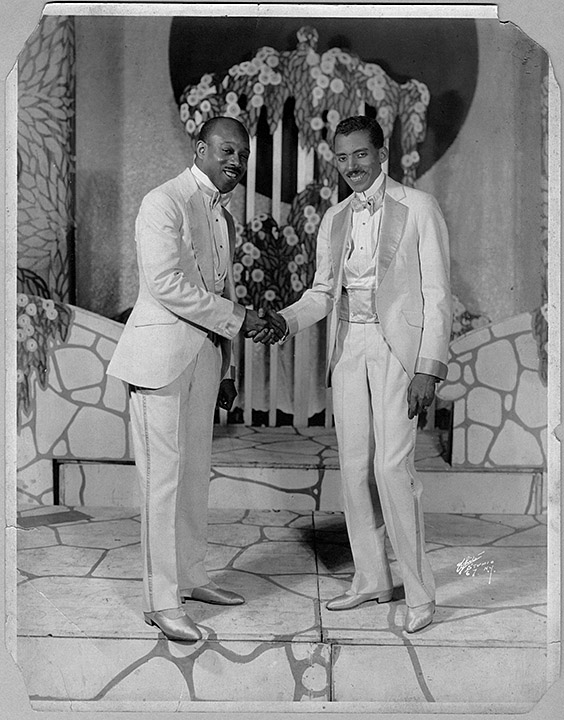The Chocolate Dandies: Blake and Sissle’s other Musical
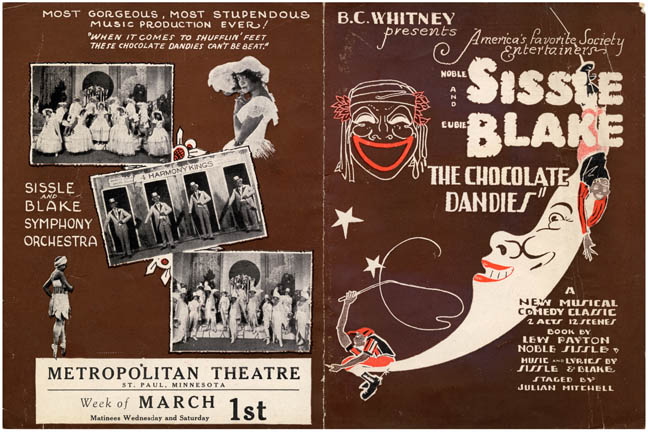
Program cover. The Chocolate Dandies, Noble Sissle and Eubie Blake, ca. 1924, MS 2800, 080-02-003, MdHS.
On April 28 of this year, Baltimore born ragtime and jazz pianist and composer Eubie Blake and his partner Noble Sissles’ most famous work, Shuffle Along, will open on Broadway, nearly 100 years after its initial run. In 1921, Shuffle Along transformed Broadway and left a far reaching cultural and social legacy. But the pair also produced another Broadway musical that is largely forgotten.
Born on February 7, 1887 at 419 Forrest Street in Baltimore to former slaves, Eubie Blake exhibited a prodigious musical talent at an early age. By age 12, he had joined a band and within a few years he was living the life of a professional musician, joining up with travelling music shows along the east coast, playing at various clubs, bars, and bordellos in his hometown, and composing. From 1907 to 1910 he played piano at the Goldfield Hotel on Lexington Avenue, owned by Lightweight Boxing Champion Joe Gans, Blake’s childhood hero.
In 1915 Blake met Indiana native Noble Sissle in Baltimore. Sensing a musical kinship, he almost immediately asked Sissle to write lyrics for his piano compositions, and a partnership was born. They wrote and performed together until World War I broke out. Sissle joined James Reese Europe and his 369th Infantry Army Band in Europe, while Blake remained in Baltimore. After Sissle returned from service, they put together a Vaudeville Act, the “Dixie Duo,” touring up and down the east coat. In 1920, Blake and Sissle met the comedy duo of Fluornoy Miller and Aubrey Lyles at an NAACP event in Philadelphia. The four men decided to embark together on the creation of a musical, based on a Miller and Lyles comedy sketch, which would eventually become Shuffle Along.
When Shuffle Along premiered on May 23, 1921 at the 63rd Street Music Hall in New York City, it was a landmark event. The first African-American produced musical to appear on Broadway in over ten years, it introduced jazz to Broadway, profoundly altering the American theatrical landscape. More importantly it led to the desegregation of Broadway theatres. Traditionally African-Americans were largely relegated to the balcony seats. With Shuffle Along, theater owners began to relax the restrictions, allowing African-American patrons to see the show from the orchestra seats. In the wake of the tremendous success of Shuffle Along with both white and black audiences, there was a resurgence of African-American produced musicals appearing on Broadway. Many of the cast members of the show went on to long and successful careers including Paul Robeson, Florence Mills, and Josephine Baker, then a sixteen year old member of the chorus line. The show ran in New York for 504 performances, an enormous success for the time. It then went on an equally successful two year national tour playing to mixed audiences in what had previously been segregated theaters.
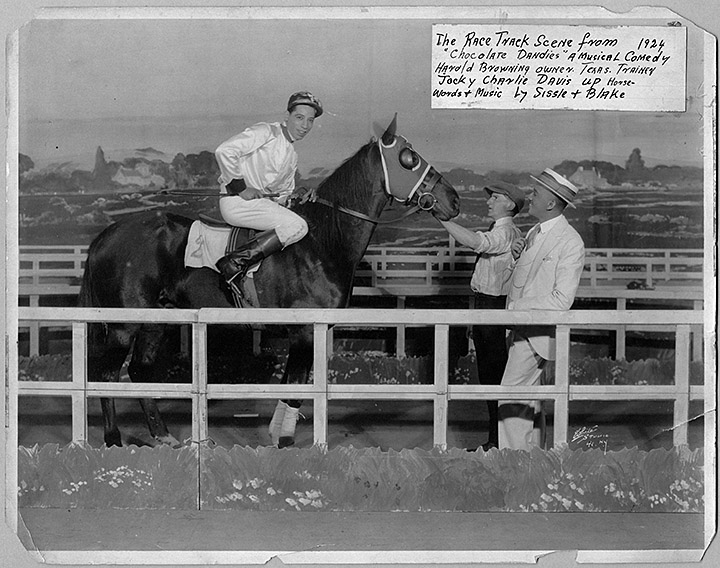
Race Track scene from “Chocolate Dandies,” a musical comedy with Harold Browning, owner of Texas Trainer and jockey Charlie Davis. Ca. 1924, Eubie Blake Photograph Collection, PP301.318, MdHS.
Essentially forgotten is Blake and Sissle’s follow-up to their huge hit. Written while Shuffle Along was still on tour, The Chocolate Dandies was the pair’s attempt to capitalize on the success of Shuffle Along and produce a musical stage show that would rival the productions of contemporary white produced musicals, like the Ziegfeld Follies and Scandals with huge casts, lavish costumes, and elaborate stage designs.
Initially titled In Bamville, the musical is a comedy-fantasy set in the fictional southern plantation town of Bamville (an African-American folk expression akin to ‘podunk town’) At the center of the town’s activity is a racetrack. The main character, Mose Washington, owner of a horse named “Dumb Luck” falls asleep before a race, and dreams that he has become wealthy after winning a horse-racing bet. When he wakes, he discovers it was all a dream – a rival race horse owner had actually won. The play ends with the marriage of the rival to the daughter of prominent citizen who live happily ever after.
In Bamville went on a 24 week tour before it opened at the New Colonial Theatre on Broadway on September 1, 1924 as The Chocolate Dandies. It also brought back some of the cast of Shuffle Along, including Josephine Baker in a more prominent role as a clown in the chorus line.

Full cast of “Chocolate Dandies” on stage with orchestra in foreground,
Ca. 1924, Eubie Blake Photograph Collection, PP301.320, MdHS.
Critical reaction to The Chocolate Dandies was mixed. One critic felt it surpassed Shuffle Along: “It is at least 50 percent better than “Shuffle Along.” That’s high enough praise for any show.”(1) The principal contention by many of the white critics was that it was not “black” enough. With their second musical, Blake and Sissle’s ambition was to create a musical with the production values of white shows, while leaving some of the racial stereotypes behind and appealing to both black and white audiences. For this the production was both praised and denounced. Ashton Stevens, the renowned drama critic for the Chicago Herald and Examiner felt that white influence had watered down the performance: “There is too much so-called politeness, too much platitudinous refinement and not enough of the racy and the razor-edged. There is in a word, too much “art” and not enough “Africa.” (2)
Hubert Harrison, one of the leading African-American political activists and radical intellectuals of the day considered the musical to be a success for the very reason that it moved beyond the stereotype of the black musical:
“’In Bamville’ is, so far, the one outstanding specimen of the genus musical comedy that our people have yet produced. I mean no offence to the others; they are many of them splendid things. But they are in the manner of that circumscribed tradition which has established fixed conventions for “Negro” musical comedy productions. But this work of your joint genius (yours and Mr. Sissle’s) meets the white man on his own ground and challenges expert critical comparison…Besides the skill in which you manage to serve two masters; pursuing the pure artistic intent while you offer your sops to the racial Cerberus – that is your greatest achievement, which the dull newspaper critics will, perhaps fortunately, fail to fathom.” (3)
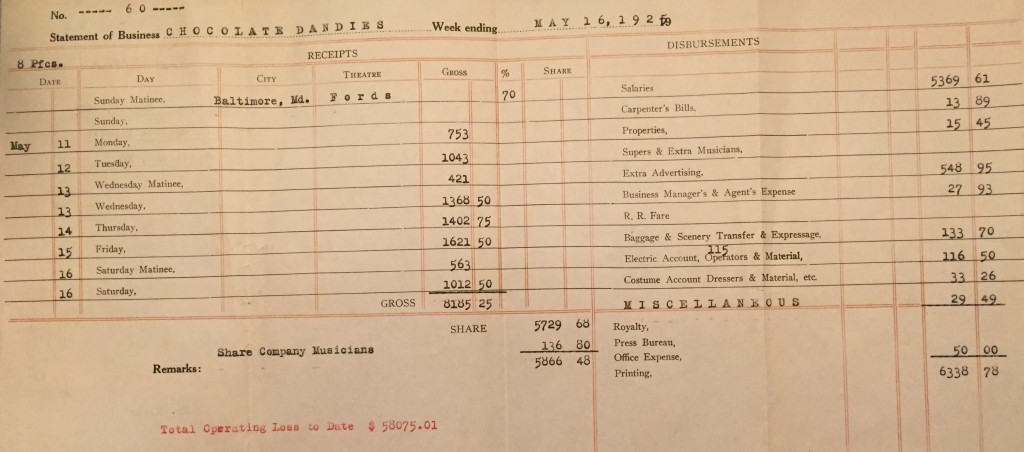
The Chocolate Dandies, Statement of Business showing losses of $58,075.01 for the week ending May 16, 1925.
Statement of Business, Chocolate Dandies, 1925, MS 2800, MdHS.
In financial terms the production was a disaster. With a cast of 125, an initial $7,500 weekly salary budget (salary cuts were made periodically over the run of the performance), and a lavish stage production including three horses that ran a race onstage, the show would have to have sold out every performance to break even. In contrast, Shuffle Along had a cast of 60, with $3700 in weekly salaries, with sold out shows for the duration of its run. After only 96 performances, The Chocolate Dandies closed in May of 1925 with nearly $60,000 in losses.
Despite the mixed critical reactions and financial failure of their follow up to the landmark Shuffle Along, Sissle and Blake were unequivocal about the merits of the musical – they both felt it was their greatest collaboration. Blake considered it his masterpiece. In an interview later in his life, Blake explained,
“I know the world thinks Shuffle Along was the best, but that is more because it was such a novelty when it came out. It was the first, and it left an indelible mark on people’s minds. But I have never written a score to compare with the Chocolate Dandies. I know there is nothing in Shuffle Along anywhere near the melodies of ‘Dixie Moon’ and ‘Jassamine Lane.’ I know what people say, but I still fight the world on it. You know, you have to have a lot of nerve to tell the whole world off, but that’s how I feel.” (4)
The Maryland Historical Society received Eubie Blake’s vast personal collection of correspondence, photographs, memorabilia and sheet music in 1982 just a year prior to his passing on February 12, 1983. Reference Librarian Francis O’Neill, just beginning his 35 year tenure at MdHS, was among the staff members that made the trek to Blake’s home in Brooklyn, New York to bring the collection to Baltimore. He can still recall Blake, spry at 96, walking around in his bathrobe while his life’s work and memorabilia were taken away for future generations.
A full inventory of Blake’s sheet music is available through the Maryland Historical Society website. Over the past year the Special Collections staff, with the help of volunteer and current Goucher student Micah Connor, has been working on a full inventory of the photograph and manuscript collections, which should be available online later this year. (Damon Talbot)
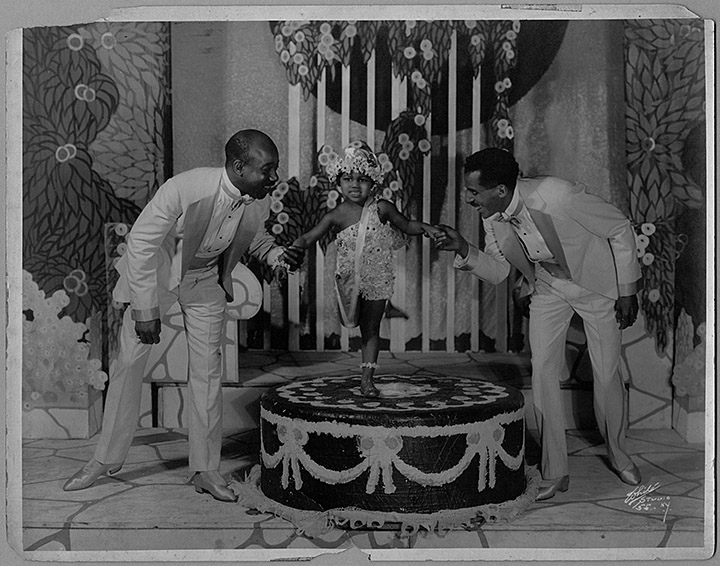
Scene from the “Chocolate Dandies.” Noble Sissle and Eubie Blake with a young female performer, ca. 1924, Eubie Blake Photograph Collection,. PP301.317, MdHS.
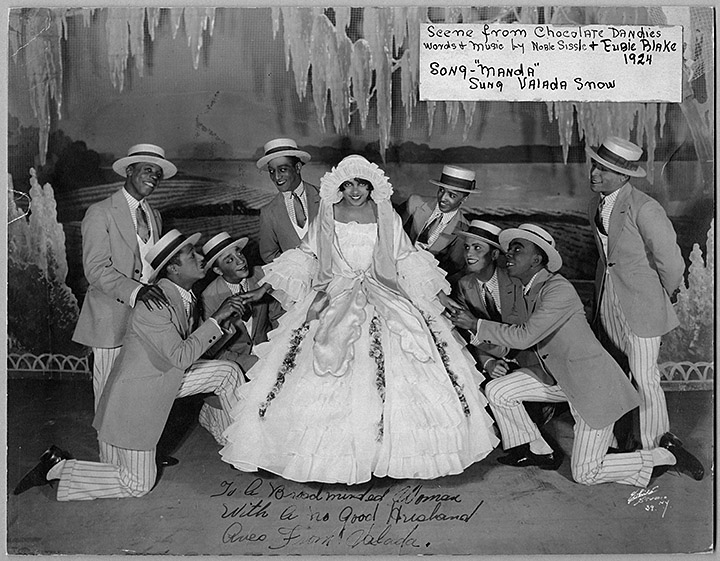
Scene from “Chocolate Dandies,” song “Manda,” sung by Valada Snow, ca. 1924, Eubie Blake Photograph Collection, PP301.319, MdHS.

Program interior. The Chocolate Dandies, Noble Sissle and Eubie Blake, ca. 1924, MS 2800, 080-02-003, MdHS.
Sources and Further Reading:
(1) Kimball, Robert and William Bolcom, Reminiscing with Sissle and Blake (The Viking Press: New York, 1973), p. 174.
(2) Ibid., 180.
(3) Hubert Harrison to Eubie Blake, June 18, 1924, Eubie Blake Manuscript Collection, MS 2800, MdHS.
(4) Kimball, 181.
Aberjhani and Sandra L. West, Encyclopedia of the Harlem Renaissance (Checkmark Books, 2003)
Gates, Henry Louis and Evelyn Brooks Higginbotham, eds., African American Lives (Oxford University Press, 2004)
Kimball, Robert and William Bolcom, Reminiscing with Sissle and Blake (The Viking Press: New York, 1973)
Osteen Mark and Frank J. Graziano, eds., Music at the Crossroads: Lives and Legacies of Baltimore Jazz (Apprentice House: Baltimore, 2010)
Rose, Al, Eubie Blake (Schirmer Books: New York, 1979)
Musical of the Month: Shuffle Along, New York Public Library Blog, February 10, 2012


